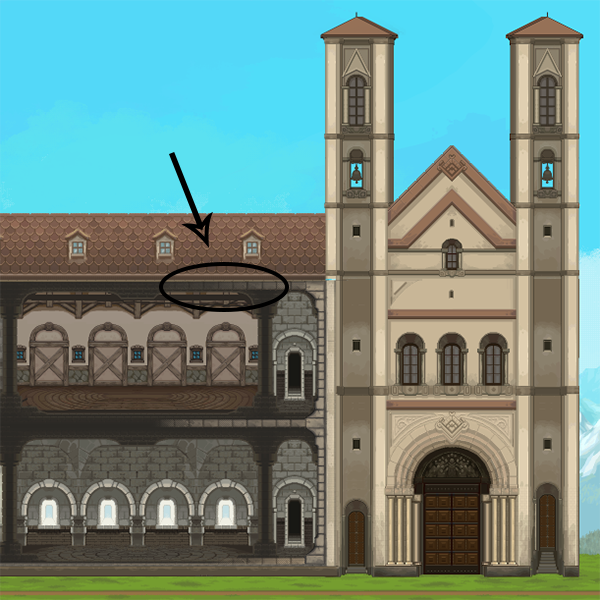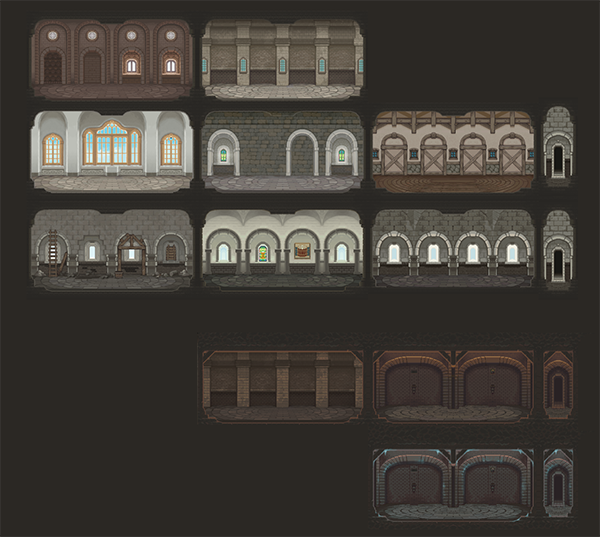Another week comes to its end and with that comes our traditional sneak peek of what transpired in Ale Abbey's development. Keeping the momentum going from last week we decided to run a small stress test on the latest internal build we have the team working on, pondered around making the interiors look more uniform, and worked on designing some assets for the Laymen.
On with the news!
-- New Layman assets
Following last week's work on the Laymen, we have another model being designed. With our focus being the multitude of diverse characters found in the Abbey, we try to make sure that every one of them manifests their personality through minutely different actions/mannerisms when they work. In this example, you will notice this Layman using a completely different method for lifting the heavy stuff.

WIP and you know it, we have to fix some issues with the hands holding the barrel there. Hopefully, they all use their knees and not their backs... proper posture and form save quality of life y'all!
-- Monastery interior fixes
The joyous task of ensuring everything looks fitting when you have too many things in very close proximity, in the same scene. This time the ever-evolving look of the Abbey's rooms. They too have to look their best when put next to each other. And remember that we are talking about rooms that are as different in function as they are in form.
With this latest version making the rooms look even better together, we will be moving our attention towards something that Emiliano and Francesco picked up: the room dividers (the midsections between rooms that are built next to each other) might accommodate multiple rooms but they do so creating unwanted perceptual mistakes (like depth when there is none).
In their latest version, these dividers were designed to look as shown below:

All three sections (the top closer to the roof, the midsection between rooms, and the lower section between room and ground) look quirky enough to be considered a bit off. Our pixel artist Raimo already gave an idea that we will have to test throughout the coming week. It's a pretty sound and promising fix, so we will have a follow-up to report next Friday ;)
-- Stress testing the brewers...
Imagine having a game about Monks and Nuns, Abbesses and Merchants, Laymen and Wanderers... And all of them living in the moment at the same time. Emiliano went through the process of discreetly stress-testing the Monastery by adding as many as 50 brewers at the same time.
It seems to be working, but we'll need to keep pushing... for science.



No brewers were harmed in the making of these scenes. Well, maybe a little stressed. And tired... definitely tired!
-- ... and then do the same with your beer!
This is of course a hobby for the avid homebrewer who also happens to have the time and money to go the extra mile like that. A brew tested to its extremes reveals the bigger picture of the puzzle that is homebrewing. The amount of information one can get by purposefully making "mistakes" while brewing is astounding and can showcase the strengths and weaknesses of their favorite homebrew.
So. What can you test?
- Temperature Fluctuations: Subject your beer to various temperature conditions, including fluctuations, to mimic potential storage variations. This helps assess how well your beer can handle temperature changes without affecting its flavor or causing off-flavors.
- Light Exposure: Exposure to light, especially sunlight, can lead to the development of off-flavors in beer. Stress testing by exposing your beer to light can help you identify and address any issues related to lightstruck flavors.
- Storage Duration: Allow some bottles to age for an extended period to test how well your beer stands up to time. This helps you understand the aging potential of your brew and whether it improves or deteriorates over time.
- Transportation Simulation: If you plan to transport your beer, simulate transportation conditions. This might include shaking the bottles gently to mimic the vibrations during transit. This can help ensure your beer remains stable and doesn't produce excessive sediment.
- Pressure Testing Bottles: Ensure that your bottles can handle the pressure generated during carbonation. This helps prevent bottle bombs by identifying weak bottles or faulty seals.
Make sure you don't do this with the only brew you have at hand. You're not stress-testing your ability to not have any beer to drink! :p
As always, enjoy your weekend responsibly, and join us next week for more Ale Abbey news!
-- Hammer & Ravens
Looking for more Ale Abbey? Or maybe you want to chat with the team and our community? Find us on:



